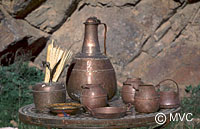Overview of Zagora
 |
| Brass Tea Set |
Rather modern in appearance, Zagora at first glance seems more important as a regional administrative centre than interesting as a place to visit. Although you will not find the historical architectural wonders of Fez and Meknès, or the richly laden atmosphere of Marrakesh, Zagora remains an interesting point from which to explore this south-eastern corner of Morocco.
Surrounding the town are the endless palm groves of the Drâa Valley, framed by the Jbel Rhart and the peaks of the Jbel Sarhro to the North and the Jbel Bani to the south. In between the greenery of the palm groves lay the Ksour, or fortified villages, whose colour and texture reflect the colour of the stone from which they built. The age of this type of settlement is reflected in the name, which is an Arabised version of the word 'Caesar'.
Almoravid Zagora
Although its origins date back to the 13th century, Zagora cannot claim to be a city of major architectural monuments, yet just south of the town, situated on the slopes of the strange, black sugar loaf hill called Jbel Zagora, the remains of an earlier Almoravid settlement still reveal their strict, rectangular grid. From here, the views across the surrounding countryside are stunning.
Palm Groves
Like the expansive succession of oases they are, the palm groves of the Drâa valley form an abundant canopy of green waving palm leaves that shelters the valley floor from the scorching sun-making this one of the most important date-producing regions in the world. Under this canopy, other produce, such as barley and vegetables, is grown.
Tamegroute
About 20 kilometres south of Zagora you will come across Tamegroute, a settlement that originally developed as a Koranic centre of learning. Here, among the ancient theological colleges, where followers of the strict Naciri brotherhood read from centuries-old original copies, there are also villagers, potters and market traders at work.
Tinfou Sand Dunes
Just south of Tamegroute are the beautiful golden sand dunes of Tinfou, whose colour changes along with the light. Dawn, dawn and night time are favoured times to climb the dunes and contemplate the surroundings.